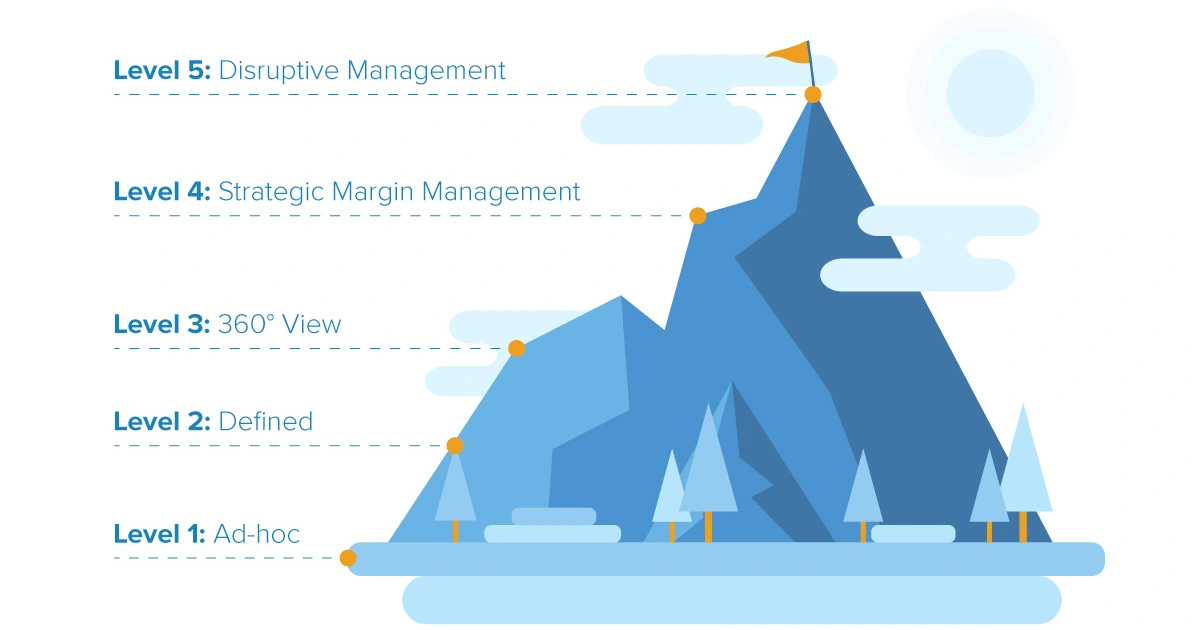Journeying from reactive to proactive revenue management
How do you approach revenue management? Are your decisions ad hoc and reactive with no standards or processes defined? Maybe you have a couple of standardized, documented processes (like tenders and rebates) and a margin management project or two in the hopper?Or, perhaps your approach is based on predictive analytics, machine learning and advanced data models. Chances are…that’s not the case, and this eBook is for you.
We discuss the five levels you can ascend to realize revenue management success:

The objective of revenue management is selling the right product, to the right customer, at the right moment through the right distribution channel…in the most cost-effective way. It’s difficult to get so many things coordinated without the right mindset and tools. That’s why so many companies remain stuck at levels 1, 2 or 3 and fail to advance to proactive and disruptive.
End-to-end lifecycle revenue management has emerged as a powerful methodology to effectively manage prices and maximize profit. The most successful organizations make it part of their culture. Margin optimization is at the center and everyone is responsible for it, not just finance. Companies that can automate their entire process also gain the substantial advantage of efficiencies, workflow collaboration, process transparency, full visibility and auditability.
The How and the Why of Your Gross to Net
Traditional gross-to-net calculations capture the basic information of how you get from list price to sales price to triple net margin. But that’s just it…they only show HOW to do it. Whether it’s on-invoice discounts or off-invoice rebates or other incentives, the secret to success is also to capture the WHY. For example, consider that 2% discount you are offering. What is the intention of it? Do you want the distributor to keep that 2% or pass it along to the customer? The purposes in those two scenarios are completely different. It’s only when you can capture the WHY of your gross to net that you can run successful analytics.
It’s also important to know what you can control and what you can’t. While a mandatory government rebate is not something you can control, you can determine how low you will price your product to win a bid. Again, this is why it’s important to understand both the HOW and the WHY of your gross to net. When you have all the information about what you can control and what you can’t, you’re able to make decisions that lead to more profitable actions. And then you can start the ascent from reactive management toward the peak of dynamic, proactive management.
End-to-end lifecycle revenue management has emerged as a powerful methodology to effectively manage prices and maximize profit. The most successful organizations make it part of their culture. Margin optimization is at the center and everyone is responsible for it, not just finance. Companies that can automate their entire process also gain the substantial advantage of efficiencies, workflow collaboration, process transparency, full visibility and auditability.
The How and the Why of Your Gross to Net
Traditional gross-to-net calculations capture the basic information of how you get from list price to sales price to triple net margin. But that’s just it…they only show HOW to do it. Whether it’s on-invoice discounts or off-invoice rebates or other incentives, the secret to success is also to capture the WHY. For example, consider that 2% discount you are offering. What is the intention of it? Do you want the distributor to keep that 2% or pass it along to the customer? The purposes in those two scenarios are completely different. It’s only when you can capture the WHY of your gross to net that you can run successful analytics.It’s also important to know what you can control and what you can’t. While a mandatory government rebate is not something you can control, you can determine how low you will price your product to win a bid. Again, this is why it’s important to understand both the HOW and the WHY of your gross to net. When you have all the information about what you can control and what you can’t, you’re able to make decisions that lead to more profitable actions. And then you can start the ascent from reactive management toward the peak of dynamic, proactive management.
To learn more about achieving excellence in revenue management, download our eBook, Reaching the Peak: Ascending to Revenue Management Excellence in Life Sciences.
